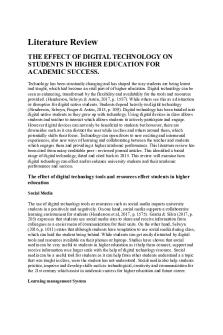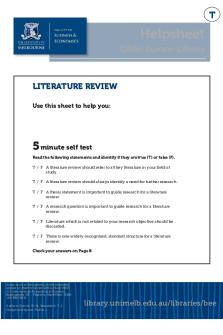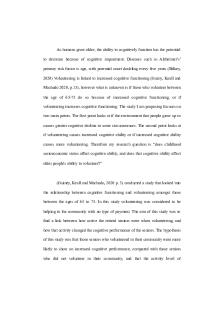Literature Review PDF

| Title | Literature Review |
|---|---|
| Course | IMC |
| Institution | Queensland University of Technology |
| Pages | 6 |
| File Size | 165.4 KB |
| File Type | |
| Total Downloads | 44 |
| Total Views | 147 |
Summary
Literature Review for AMB202. Secondary Part of Hot Topic Powerpoint....
Description
AMB202
Literature Review – Analyse how synergy works in an IMC framework Wayne Chambers
Abstract Marketing plays a crucial role in the success of almost every organisation. However, marketing is constantly evolving much like everything in the modern world. Integrated marketing communication brings together different levels of a corporation who all centre around achieving the common goal of the corporation.
Contents Abstract.................................................................................................................................................1 Literature Review...................................................................................................................................3 Conclusion.............................................................................................................................................4 Reference...............................................................................................................................................4
Literature Review Recent studies have shown that Integrated marketing communication (IMC) has evolved from a oneway communication for corporations to make maximum sales to a principle executed by exchanging values between corporations and consumers (Einwiler, S. Boenisk, M. 2012). This literature review will analyse how synergy plays a role in the communication process of IMC. Synergy is the interaction or cooperation of two or more organisations or other agents to produce a combined effect greater than the sum of their separate effects (Dresler-Hawke,E. 2006). The communication process must be understood before analysing the impacts of synergy. Table 1: Elements in the communication process
As shown in table 1, the communication process consists of 8 channels, all of which serve individual purposes and goals. However, to achieve synergy all the channels must centre towards the marketing goal of the corporation (Duncan, T.R, 2004). Through cross functional communication planning, corporations are able to obtain greater results from their marketing objectives (Duncan, T.R, 2004). For example, If the message is created by the source, and released through message channels to the receiver, however the receiver is not able to match the communication outcomes with their communication objectives, thus forms a negative or no brand impression. It is evident that this might occur as a result of lack of synergy. However, using feedback from the receiver can enable the source to produce message that correlate with the anticipated communication objectives thus achieving the marketing objectives of the corporation (Eagle, L. Kitchen,P. 2000). The underlying idea of synergy in the communication process is that each channel must perform its own objectives but do so in a way that it will enhance the outcome of the other channels (Dresler-Hawke, E, 2006). A study knows as ‘Image Transfer Study’ was conducted by a consortium of radio networks to augment the literature on cross-media synergy. The sample consisted of 500 people aged between 20- 44 from several parts of Britain (Prasad, D. Kumar, M. 2016). The study concluded that 73% of participants remembered prime visual elements of television advertisements upon hearing radio commercials (Prasad, D. Kumar, M. 2016). Furthermore, 57% percent relieved television advertisements upon hearing radio commercials (Prasad, D. Kumar, M. 2016). It is evident that radio commercials strengthened the imagery created by television advertisements. In relation to the communication process, the study used to two different message channels each with separate creative content but by centring the main marketing objective, was able to present consumers with the same themes and ideas and achieve cross media synergy. It can be evaluated that the in order for the participants to have exposure to both message channels, the source must have conducted adequate research on its audience, which subsequently let to the appropriate communication
objectives and messages being adopted. The feedback from the participants can then be used to further improve communication objectives, messages and the utilisation of message channels.
Conclusion From the literature overview is it evident, how synergy affects the communication process of IMC. The different elements in the framework all play an important individual role but with the interplay of the elements, they are able to, through synergy, enhance the outcome all the elements.
Reference Dresler-Hawke, E., & Veer, E. (2006). Making healthy eating messages more effective: combining integrated marketing communication with the behaviour ecological model. International Journal of Consumer Studies, 30(4), 318-326. Duncan, T. R., & Mulhern, F. (2004). IMC A White Paper on the Status, Scope and Future of IMC. Northwestern University and University of Denver. Eagle, L., & Kitchen, P. J. (2000). IMC, brand communications, and corporate cultures: client/advertising agency co-ordination and cohesion. European Journal of Marketing, 34(5/6), 667686. Einwiller, S. A., & Boenigk, M. (2012). Examining the link between integrated communication management and communication effectiveness in medium-sized enterprises. Journal of Marketing Communications, 18(5), 335-361. Finne, Å., & Grönroos, C. (2009). Rethinking marketing communication: From integrated marketing communication to relationship communication. Journal of Marketing Communications, 15(2-3), 179195. Grove, S. J., Carlson, L., & Dorsch, M. J. (2007). Comparing the application of integrated marketing communication (IMC) in magazine ads across product type and time. Journal of Advertising, 36(1), 37-54. Holm, O. (2006). Integrated marketing communication: from tactics to strategy. Corporate Communications: An International Journal, 11(1), 23-33. Keller, K. L. (2009). Building strong brands in a modern marketing communications environment. Journal of marketing communications, 15(2-3), 139-155. Kerr, G., & Patti, C. (2015). Strategic IMC: From abstract concept to marketing management tool. Journal of Marketing Communications, 21(5), 317-339. Naik, P. A., & Raman, K. (2003). Understanding the impact of synergy in multimedia communications. Journal of Marketing Research, 40(4), 375-388. Percy, L. (2016). Strategic advertising management. Oxford University Press. Prasad, D. A., & Kumar, M. A. (2016). INTEGRATED MARKETING COMMUNICATION: A. International Journal of Marketing and Technology, 6(9). Porcu, L., Barrio-García, S. D., & Kitchen, P. J. (2012). How Integrated Marketing Communications (IMC) works? A theoretical review and an analysis of its main drivers and effects.
Reid, M. (2002). Building strong brands through the management of integrated marketing communications. International Journal of Wine Marketing, 14(3), 37-52. Tafesse, W., & Kitchen, P. J. (2017). IMC–an integrative review. International Journal of Advertising, 36(2), 210-226....
Similar Free PDFs

Literature Review
- 10 Pages

Literature Review
- 9 Pages

Literature Review
- 6 Pages

Literature Review
- 32 Pages

Literature Review
- 9 Pages

Literature Review
- 5 Pages

Literature Review
- 15 Pages

Literature Review
- 4 Pages

Literature Review
- 16 Pages

Systematic Literature Review
- 9 Pages

Mobile Learning Literature Review
- 26 Pages

Literature review on IFRS
- 11 Pages

Literature Review - guidelines
- 4 Pages

Chapter-2: LITERATURE REVIEW
- 48 Pages

Distance Education Literature Review
- 12 Pages
Popular Institutions
- Tinajero National High School - Annex
- Politeknik Caltex Riau
- Yokohama City University
- SGT University
- University of Al-Qadisiyah
- Divine Word College of Vigan
- Techniek College Rotterdam
- Universidade de Santiago
- Universiti Teknologi MARA Cawangan Johor Kampus Pasir Gudang
- Poltekkes Kemenkes Yogyakarta
- Baguio City National High School
- Colegio san marcos
- preparatoria uno
- Centro de Bachillerato Tecnológico Industrial y de Servicios No. 107
- Dalian Maritime University
- Quang Trung Secondary School
- Colegio Tecnológico en Informática
- Corporación Regional de Educación Superior
- Grupo CEDVA
- Dar Al Uloom University
- Centro de Estudios Preuniversitarios de la Universidad Nacional de Ingeniería
- 上智大学
- Aakash International School, Nuna Majara
- San Felipe Neri Catholic School
- Kang Chiao International School - New Taipei City
- Misamis Occidental National High School
- Institución Educativa Escuela Normal Juan Ladrilleros
- Kolehiyo ng Pantukan
- Batanes State College
- Instituto Continental
- Sekolah Menengah Kejuruan Kesehatan Kaltara (Tarakan)
- Colegio de La Inmaculada Concepcion - Cebu
